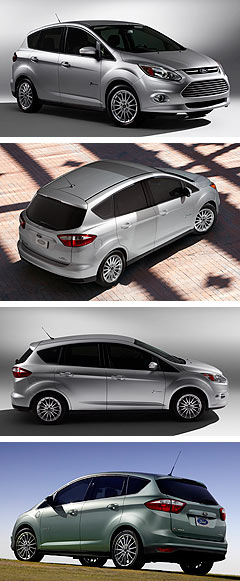Detroit show: Ford plugs in with C-Max hybrids
BY TERRY MARTIN | 11th Jan 2011

The plug-in ‘range-extending’ Energi and full-hybrid known simply as the C-Max Hybrid are among five new electrified vehicles Ford will bring to market by 2013, joining the Ford Focus Electric EV (also on show in Detroit) and a Transit EV already in limited production.
A second next-generation hybrid is also in the works, for release in the US next year and Europe in 2013.
Ford is targeting an 800km driving range for the C-Max Energi – which combines an Atkinson-cycle four-cylinder petrol engine and a lithium-ion battery pack – and is claiming the vehicle will deliver better charge-sustaining fuel economy than the Chevrolet Volt.
The company also claims the Energi’s battery recharging time should be faster than both the Volt and the Nissan Leaf – just as it has claimed with the Focus Electric – but has not issued specific details.

The Volt takes around four hours for a full recharge on a domestic 240-volt outlet, while the Leaf takes up to seven hours using the same supply.
Virtually all key specifications of the new C-Max hybrids are still to be revealed, but the Energi’s combustion engine is understood to be a 2.0-litre petrol unit and Ford has confirmed it will use the same basic ‘powersplit’ architecture as the front-drive Fusion Hybrid, which employs a 116kW/184Nm 2.5-litre Duratec Atkinson-cycle engine, a 30kW electric motor and a continuously variable transmission.
Significantly, however, the Fusion uses a nickel-metal hydride battery rather than lithium-ion, which Ford also this week said would be used on the similarly configured (non-plug-in) C-Max Hybrid.
Company engineers said the C-Max Hybrid would operate in fuel-saving electric mode beyond the Fusion Hybrid’s maximum 75km/h, adding that it would likewise deliver better economy than the eco Fusion’s 41mpg (5.7L/100km).
Both C-Max models are restricted to five-seat body styles of the C-Max and will not have rear sliding doors seen on other variants.
As with the Focus Electric, C-Max Energi owners will have access to on-board and off-board driver information systems that are designed to help them manage the recharging process and other functions, such as monitoring battery power level.
North American production will take place alongside the 2012 Focus and Focus Electric – both of which are built on the same C-segment platform as the C-Max – at Ford’s assembly plant in Wayne, Michigan, while European versions of the C-Max hybrids will be built at Ford’s plant in Valencia, Spain.
Ford said the development of its inaugural production plug-in hybrid leverages more than 320,000km of road testing conducted in collaboration with a coalition of 10 utility companies, the US Department of Energy, the New York State Energy Research and Development Administration and the Electric Power Research Institute.
Ford director of global electrification Nancy Gioia said: “C-Max Energi and C-Max Hybrid will be perfect for families looking to maximise their hybrid car experience.
“Thanks to the versatile interior, these cars are going to appeal to environmentally conscious consumers who need room to grow.”